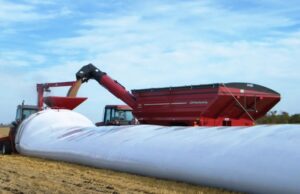The agro climatic conditions of the reporting period largely corrected the phytosanitary situation in the agrocenoses of Ukraine.
This was reported by the press service of the Food Safety and Veterinary Service of Ukraine.
In particular, the increased air temperature in early April accelerated the development of harmful organisms and their colonization of crops, where they feed. At the end of April, rainfall and increased humidity at positive temperatures contributed to the development and spread of diseases of winter grain crops and rapeseed, but negatively affected the harmfulness of phytophages.
Quite widely the sowings of winter crops and seedlings of spring cereal crops were affected by cereal fleas, piliases, gramineous aphids and leafhoppers which damaged 2% – 11% of the crops. Protective measures against the aforementioned phytophages are recommended to be carried out by spraying edge strips or continuous crops when exceeding Economic Harmfulness Threshold (ground beet larvae: 3-4 or more, bread blighters: 30-50, Lema melanopus beetles: 10-30 per square meter, cereal flies: 40-50 specimens per 100 p.s.) by recommended insecticides.
In the steppe as well as the forest-steppe areas there is a steady rise of the Eurygaster integriceps bug population, which negatively affect the crops in the wintering areas. In the Kherson region, 10% – 30% of the bug migrated from the wintering grounds to the winter crops sowings and 70% – 90% of the pest is still in the surface layer of leaf litter. However, rains that took place at the beginning of the week and a decrease in air temperature delayed the bug from affecting the winter crops.
When carrying out phytosanitary monitoring for detection of grain crops pests, it should be taken into account that in cool weather they are moving in the lower tiers of the herbage. Mass migration to the crops occurs at the onset of stable warming (at an average daily temperature of 16-17° C and higher, which lasts for 3-4 days).
Around 3% – 50% of the surveyed areas contained powdery mildew , Helminthosporium, root rot, brown leaf rust (1% – 12%), Septoria (18% – 34%) on farms of Kiev, Mykolaiv and Cherkassy regions. In sowings of winter rye and barley (Lviv region) up to 6% of plants were affected by Rhinchosporium. So to say, high-performance crops during the growth of plants in the tube are usually sprayed by fungicides of the appropriate action spectrum.
In the steppe and forest-steppe areas, pea shoots were colonized and damaged by nodule weevils, Opatrum sabulosum bugs and southern gray weevil. Perennial grasses were damaged by nodule weevils, leaf alfalfa weevil, seed-eaters, bugs and Opatrum sabulosum bugs as well. Of the diseases, the development of brown spot on the alfalfa was observed.
Sowings of winter rapeseed were mainly affected along the margins of fields by: cabbage weevil and large rapeseed weevil, cruciferous fleas, rapeseed leaf beetles, which damaged 2% – 9% of the crops (20% of plants in moderate condition) in Kiev and Cherkasy regions. From 6% – 13% of the surveyed areas were affected by: sporulation, alternativeosis, phomosis. Bacteriosis of the roots was observed on 2% – 12% of sowings in Lviv and Cherkasy regions.
In farms where the pest exceeded Economic Harmfulness Threshold (rapeseed weevil – 1-2 beetles per plant; cabbage seed weevil – 2 beetles per 40 plants), it is necessary to conduct continuous spraying with approved chemicals.
In the gardens, the development and nutrition of weevils still continues (Sciaphobus squalidus, Anthonomus pomorum), which already damaged 1% – 18% of the shoots. The revival of such pests as ticks, aphids and other continues with 2% – 10% damage of the shoots observed on 20% – 60% of the trees. In the Cherkassy region, 10% of trees were damaged by Tropinota hirta in 15% of the areas with an average of 1 imago per tree. Occasionally, there were about 18 specimens observed in Smelyansky area on apricot tree and 3 specimens per square meter in strawberry plants. In order to protect the plants during such periods of time it is recommended to treat tree buds with insecticides with the addition of chemicals against the diseases.
Nevertheless, most of the farms provide constant phytosanitary supervision of agricultural crops and the situation is looking rather optimistic for the future harvests.






